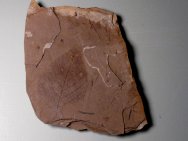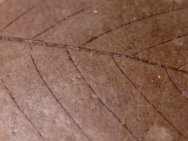|
 Coming
from the McAbee Fossil Beds in British Columbia, Canada, this
Middle Eocene plant fossil plate represents some of the defining
events of Paleobiology in the Tertiary (see discussion below).
The high-carbon fine preservation is owing to a fine layer of
silt that accumulated over the years as a result of deposition
of diatoms that bloomed in the lake each spring and died in the
summer. The leaf fossils are most beautiful in the fragile shale.
This matrix contains a nice Alder leaf in an aesthetic display;
there is also a poorly preserved Coming
from the McAbee Fossil Beds in British Columbia, Canada, this
Middle Eocene plant fossil plate represents some of the defining
events of Paleobiology in the Tertiary (see discussion below).
The high-carbon fine preservation is owing to a fine layer of
silt that accumulated over the years as a result of deposition
of diatoms that bloomed in the lake each spring and died in the
summer. The leaf fossils are most beautiful in the fragile shale.
This matrix contains a nice Alder leaf in an aesthetic display;
there is also a poorly preserved  insect. insect.
The
McAbee Fossil Beds site is a Konservat-Lagerstätten owing
to the exceptional preservation of the flora and fauna. The fossils
are the most diverse known in British Columbia for plants and insects
of the Eocene. Only a small fraction of the diversity has yet to
be formally described. Some 76 plant genera are known so far. The
fossil site was recently acquired by the British Columbia provincial
government and declared a heritage site. As a consequence, specimens
like this that were collected from before the declaration will
become increasingly in demand as no further material will be available.
The
Eocene was a period when flowering plants continued a massive
radiation that began in the Paleocene Epoch. Plants thrived,
and
with that many animals, as new environmental niches were filled.
The first grasses appeared with growth near the root as opposed
to the tip, providing a renewable food resource and place of
refuge for many animals. Small mammals radiated. Many new species
of shrubs,
trees and small plants appeared. A variety of trees thrived in
a warm Eocene climate, including beech, elm, chestnut, magnolia,
redwood, birch, and cedar, and more. The evolution of plants
was providing a powerful selective pressure across the entire
animal
Kingdom, and many new symbiotic systems appeared
. |

 insect.
insect.

